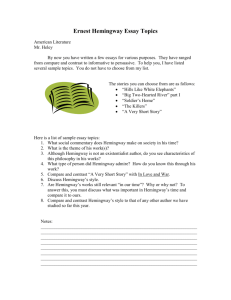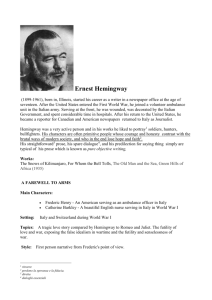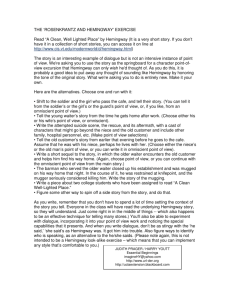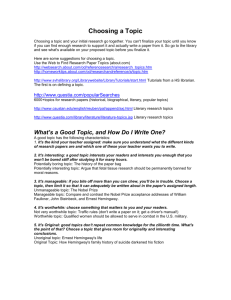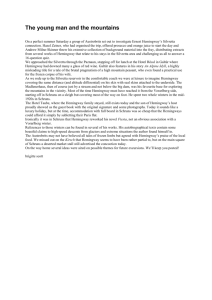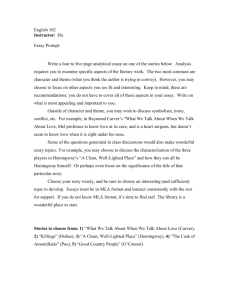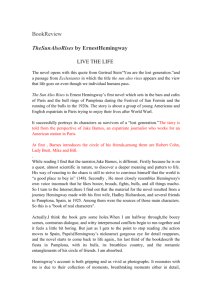Hemingway's depiction of women in A Farewell to Arms
advertisement
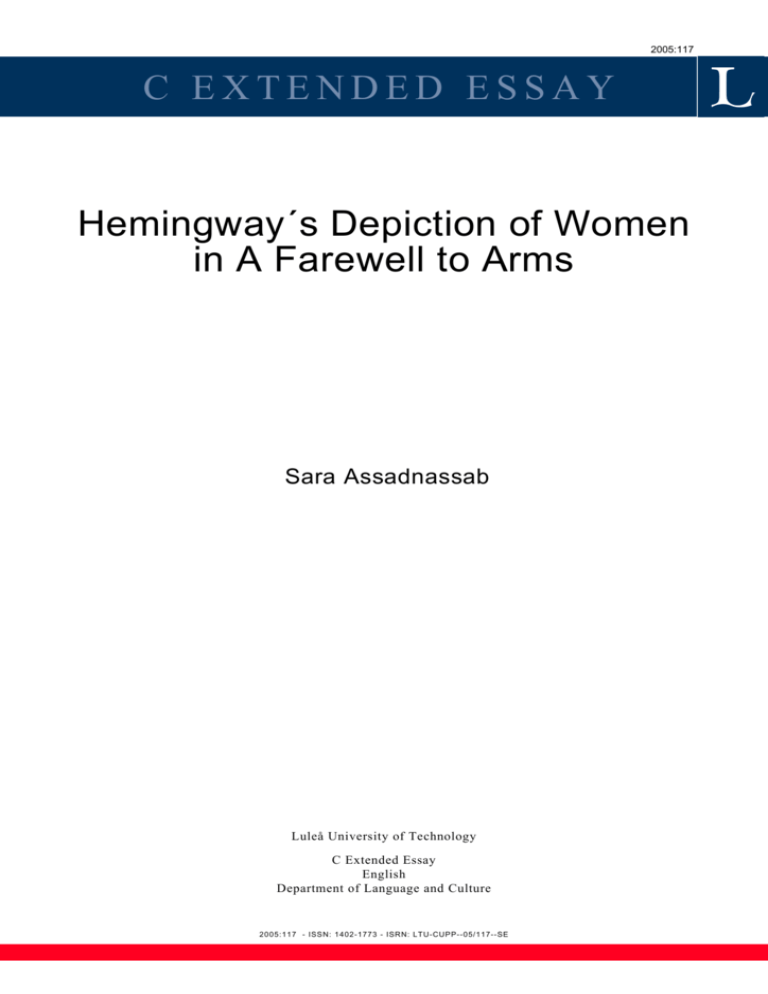
2005:117 C EXTENDED ESSAY Hemingway´s Depiction of Women in A Farewell to Arms Sara Assadnassab Luleå University of Technology C Extended Essay English Department of Language and Culture 2005:117 - ISSN: 1402-1773 - ISRN: LTU-CUPP--05/117--SE Hemingway’s depiction of women in A Farewell to Arms SARA ASSADNASSAB Department of Language and culture English C Supervisor: Dr. Billy Gray Table of Contents Introduction 1 Catherine Barkley and the Critics 3 Sexuality and Gender Role 6 Concept of Love 9 The Forgotten Female 13 The language 19 Conclusion 21 List of Works Cited 22 Introduction Ernest Hemingway (1899-1961), born in Oak Park, Illinois, started his career as a writer in a newspaper office in Kansas City at the age of seventeen. After the United States entered the First World War, he joined a volunteer ambulance unit in the Italian army. Serving at the front, he was wounded, was decorated by the Italian Government, and spent considerable time in hospitals. After his return to the United States, he became a reporter for Canadian and American newspapers and was soon sent back to Europe to cover such events as the Greek Revolution. During the twenties, Hemingway became a member of the group of expatriate Americans in Paris, which he described in his first important work, The Sun Also Rises (1926). Equally successful was A Farewell to Arms (1929), the study of an American ambulance officer's disillusionment in the war and his role as a deserter. Hemingway used his experiences as a reporter during the civil war in Spain as the background for his most ambitious novel, For Whom the Bell Tolls (1940). 1 A Farewell to Arms is the typical classic story that can be compared to Romeo and Juliet placed against the odds. It is clear that in all of Hemingway's books and from his own life, he sees the world as his enemy. As Johnson says” He will solve the problem of dealing with the world by taking refuge in individualism and isolated personal relationships and sensations.”2 In recent years Hemingway often has been the target of feminist critics, and none of them has stated her cause more forcefully than Judith Fetterly. “Why 1 2 Carlos Baker. Hemingway: The Writer as Artist (Princeton University Press: Princeton, NJ, 1972). Arthur Waldhorn, A Reader's Guide to Ernest Hemingway (New York: Farrar, Straus, and Giroux, 1972). 1 does the emotional charge of this novel and others on the same theme, so often depend on the death of the woman and so rarely on the death of the man?” Behind the idealization of Catherine in A Farewell to Arms, she believes, “is a hostility whose full measure can be taken from the fact that Catherine dies and dies because she is a woman.” If we weep at the end, she asserts, it is not for Catherine but for Fredric, because in the novel it is male life that matters.3 The purpose of this essay, however, is not to create justice for Hemingway. I attempt to show Hemingway’s depiction of women and of gender issues by comparing them in their historical and biographical context and to realize how he reflects his attitude toward gender and sex in his era. 3 Judith Fetterly, A Farewell to Arms: “Hemingway’s Resentful cryptogram”, in The Resisting Reader: A Feminist Approach to American Fiction (Bloomington: Indian University press, 1978). 2 Catherine Barkley and the critics Catherine is a kind of Athena, a beautiful, cool girl. She denies formal religion as a source of comfort. Her character is static. She is the modern woman who has rejected all of the traditional values. She has no religion; instead she and Henry’s devotion to each other came to be known as the constant factor around which they organize their lives. Catherine’s death made Frederic see that everything is vain and empty. The critic Scott Donaldson writes; in this novel she emerges as the truly heroic figure of the book. Her willingness to submerge herself in a personal relationship, far from being a sign of female spinelessness, is an act of will. A model of courage and stoic selfawareness, Catherine is determined to forge a meaningful and orderly existence if only temporarily in a world in which all traditional notions of meaning and order has been shattered.4 In 1980, Linda Wagner argued that, “at least in Hemingway’s early fiction the women have already reached that plateau of semi-stoic self-awareness which Hemingway’s man have, usually, yet to attain, but she felt Catherine’s submissiveness and languor disqualified her from that company.”5 In 1949, Ray B. West, noted that “it takes Catherine’s death to teach Fredric what she had known from the beginning: that death is the end of it.” To counteract the bias of critics whose focus on Frederic tends to blur Catherine’s development, a feminist interpretation must focus on her. One of 4 Scott Donaldson, A Farewell to Arms: “Catherine Barkley and the Critics” (The Cambridge companion to Ernest Hemingway, Cambridge UP, 1996). 5 ibid 3 the angriest feminist attacks on Hemingway fails to do this. Judith Fetterly is unable to regard Catherine as distinct character: In fact, Catherine’s contradictions are not resolvable, because forces outside her determine her character; it is a reflection of male psychology and male fantasy life and is understandable only seen as a series of responses to the needs of the male world that surrounds her.6 As Philip Young has mentioned, “Catherine is the most believable of Hemingway's female protagonists, memorable despite being idealized and compliant.” He also praises the minor characters--the priest, Rinaldi especially, Count Greffi, and the Italian ambulance drivers--as real, particularly due to their language patterns.7 In my opinion, Catherine is the modern woman who runs away from obstacles and traditions. She has learned to disobey, and she has broken the customs of her time. This is clear when Frederic thinks that they will marry, but he is shocked when he understands that Catherine won’t. After learning she is pregnant, she tells Frederic how small obstacles seemed very big, and she carries on with a very nice phrase: “Life isn’t hard to manage when you have nothing to lose.” She is self-confident and competent enough to accept the society in which the war is taking place. Whether or not these points of views are right, the critical speculation regarding Catherine is a case study in which personal and cultural values of the critics make the novel dark or bright for us. 6 Judith Fetterly, The resisting reader: “A Feminist Approach to American Fiction”66-71. Philip Young, Ernest Hemmingway: “A Reconsideration” (University park: Pennsylvania State University, 1966) 524. 7 4 However I think that we should consider her as a brave woman of her own time who lives by a definite, unshakeable value system, and her values are love and courage. Despite everything, love is her religion until the instant she dies. She experienced romantic love in which she wants to forget the war. 5 Sexuality and gender roles From the beginning of Hemmingway’s career, critics made an issue of the ‘masculinity’ of his writing. His early stories won wide critical praise for their stoic understanding, ‘masculine’ style and their graphic depiction of male pursuits and attitudes. By the early 1930s, Hemingway was working deliberately to develop and embellish a masculine public image of himself. As he turned into a male celebrity as well as one of America’s best-known authors, some serious readers began to have second thoughts. Critics of the novel declared that Hemingway could not depict women or that he was better at depicting men without women.8 In the 1960s with the rise of feminist criticism in literature departments, Hemingway, was accused of perpetuating sexist stereotypes in his writing which led to a diminishing of his literary reputation in some academic circles.9 His short stories and novels were based on his anxieties about masculinity, gender roles and sexuality in American, and western society. In nineteenthcentury America men and women were assumed to be, by nature, complementary opposites. American society was, in effect, divided into male and female spheres, each sphere being associated with certain gendered values. The man’s sphere required the attitudes of emotional and moral toughness necessary for survival in the competitive public world. Why is Hemingway so careful to exonerate the doctor from blame for the death? With his dialogue of choices, Hemingway ensures that the doctor in A Farewell to Arms is no villain. The doctor, in fact, has almost no individual character. Nameless and faceless, he becomes simply ‘Doctor’, a 8 Leslie A Fiedler, Love and Death in the American Novel (New York, Dell, 1960) 318. Scott Donaldson, A Farewell to Arms: “Hemingway and Gender History” (The Companion to Ernest Hemingway, Cambridge UP, 1996) 171. 9 6 representative of the medical system and of the masculine world. His choices are limited within this framework and, therefore, not individual choices at all. Hemingway implicates the masculine system for Catherine’s death. As in ‘Indian Camp’, the doctor’s actions help uncover a male character’s distrust of the masculine power realm.10 Frederic Henry realizes: Now Catherine would die. That was what you did. You died. You did not know what it was about. You never had time to learn. They threw you in and told you the rules and the first time they caught you off base they killed you. Or they killed you gratuitously like Aymo. Or you gave the syphilis like Rinaldi. But they killed you in the end. You could count on that. Stay around and they would kill you. Hemingway presents this structure through the doctor figure, and with characters like Nick and Frederic, explores the damage the patriarchal system enacts upon men. Hemingway is as wary of the negative power of male discourse for men as Charlotte Perkins Gilman is of its destructive Power for women. Measured by the gender standards current during World War I and extending in to the late 1920 when Hemingway composed the book, Catherine is depicted as a modern, independent young woman. Her ethical and moral standards are much more orthodox. She is self-reliant and competent but without the cruelty or mannishness displayed by some strong women in Hemingway’s later fiction. She is qualified to run away with the man she loves and to help him domesticate the world of his wishful dreams. Contrary to Leslie Fiedler’s view that “Hemingway’s men prefer each other’s company and the dangers of the manly world to the responsibilities 10 ibid 7 associated with women and civilization”, the protagonist of this novel flees from the corrupt and untrustworthy male world into a woman’s arms.11 Fetterley observes, accurately, “The opening attitude toward women at the Italian front is sexual”. She even lambastes the poor priest as the archetype of the man without women as an ideal of the culture. Fetterley finds another easy target in the moronic doctor who let Catherine bleed to death, Henry for not spotting the phony soon enough; and attacks the doctor's paternalism in pooh-poohing Catherine's fear that she might die in childbirth. When she states that “Catherine's death is finally seen as a childish and irresponsible act of abandonment”, she is characterizing the doctor's stupid attitude, but she neglects to separate his opinion from Frederic or Hemingway's. Fetterley claims that Frederic sees women in authority “as smug, selfrighteous, critical, anti-sexual, and sadistic”. Of course, Fetterley picks on Frederic's dealings with the nurses in Milan before his love of Catherine has fully transformed him. Though she does also point to Frederic's hustling the nurses out of Catherine's death chamber in the Swiss hospital. After attacking Frederic for being egotistical when he is brought to Milan, Fetterley notes that Frederic deals with women on the basis of their sexuality, and lobs the tautology that “Frederic would never have fallen in love with Catherine if she were not beautiful. Beauty maybe not even her beauty that hooks Frederic but her craziness, her (gasp!) vulnerability, shown in that crazy game when she manipulates Frederic into pretending he's her dead fiancé come back from the war.”12 11 Rena Sanderson, A Farewell to Arms: “Hemingway and Gender history” (The Cambridge companion to Ernest Hemingway, 1996). 12 Judith Fetterly, A Farewell to Arms: “Hemingway’s Resentful cryptogram”, in The resisting Reader: A feminist approach to American fiction. 8 Concept of love Love is a strong emotion that can give a sense of meaning in everyone’s life, but one must not trust totally because it can be easily taken away. When you love you wish to do the best for another one. Love exists in this novel, and makes it more complicated. War is savage and unnecessary, but it can be tolerable with love. In this novel, love starts in wartime, which is quite natural as it is a time of hardship. Frederic Henry is an ambulance driver and Catherine Barkley is an English nurse. He meets her, but actually he doesn’t fall in love with her until he is injured and is put in a hospital. They begin to have a love affair and Catherine becomes pregnant. With her pregnancy Henry feels a sense of responsibility for her. There is great deal of death in the war, which Frederic doesn’t like to participate in. They decide to escape to Switzerland and begin to live happily. Their relationship brings value to his life, which Frederic realizes is love. Hemingway's language is effective in leaving much to the reader’s interpretation and allowing a different image to form in each readers mind. The simple sentences and incomplete descriptions free imagination and inspire each person to develop their own bitter love story. The love that Frederic and Catherine have for each other is more than can be explained in words and Frederic makes it known that words are not really effective at describing the flesh and blood details. Their love during an ugly war isn’t to be recreated or modeled even as much as through a baby conceived by their 9 love. The baby cannot be born alive because their love is beautiful yet doomed, so that nothing can come out of it.13 John Stubbs believes that “Henry and Catherine used to protect themselves from the discovery of their insignificance and powerlessness...in a world indifferent to their well being.” He asserts, “Role-playing by the two main characters, and several others in the book, is a way to escape the realization of human mortality which is unveiled by war”. Stubbs thinks, “Hemingway utilized role-playing as a way to explore the strengths and weaknesses of his two characters.” He argues that “by placing Henry's ordered life in opposition to Catherine's topsy-turvy one, and then letting each one assume a role which will bring them closer together, Hemingway shows the pair's inability to accept the hard, gratuitous quality of life.”14 Stubbs begins by showing other examples, notably in In Our Time and The Sun Also Rises, in which Hemingway's characters revert to role-playing in order to escape or retreat from their lives. The ability to create characters that play roles, he says, either to ‘maintain self-esteem’ or to escape, is one Hemingway exploits extraordinarily well in A Farewell to Arms and therefore it “is his richest and most successful handling of human beings trying to come to terms with their vulnerability.”15 As far as Stubbs is concerned, Hemingway is quite blatant in letting us know that role-playing is what is occurring. He argues that the role-playing begins during Henry and Catherine's third encounter, when Catherine directly dictates what Henry speaks. After this meeting the two become increasingly comfortable with their roles and easily adopt them whenever the other is nearby. This is 13 14 15 http://www.cyberessays.com/. Bruccoli, Matthew J. and Clark, C.E. Frazer (ed.), (http://www.cyberessays.com/English). Ibid. 10 apparent also in that they can only successfully play their roles when they are in private and any disturbance cause the ‘game’ to be disrupted. The intrusion of the outside world in any form makes their role-playing impossible, as evidenced at the racetrack in Milan, where they must be alone. The people surrounding them make Catherine feel uncomfortable and Henry has to take her away from the crowd. He goes on to describe how it is impossible for them to play the roles when they are apart and how they therefore become more dependent upon each other's company. Stubbs goes on to explain how, “neither mistakes role-playing for a truly intimate relationship, but both recognize that it can be a useful device for satisfying certain emotional needs.” He says “originally Henry and Catherine are playing the ‘game’ for different reasons but eventually move to play it as a team. Henry is role-playing to regain the sense of order he has lost when he realizes the futility of the war and his lack of place in it. Catherine is roleplaying to deal with the loss of her fiancé and to try to find order in the arena of the war. When they are able to role-play together, the promise of mutual support’ is what becomes as important to them as they try to cope with their individual human vulnerability.” He also analyzes the idyllic world introduced early in the story by the priest at the mess and later realized by Henry and Catherine in Switzerland. They fall fully into their roles when they row across the lake on their way to their idealized world. The fact that they actually are able to enter this make-believe world strengthens their ‘game’ and allows it to continue longer than it would have otherwise. And once they are in this new world they adopt a new role, which allows them to continue their ruse. They also need to work harder to maintain the ‘game’ because far from the front they are both still aware the war is proceeding and 11 they are no longer a part of it. The world in which they exist in reality is not conducive to role-playing because it tries repeatedly to end their ‘game’.16 16 http://www.bigwonk.com/. 12 The Forgotten Female Ernest Hemingway has often been accused of misogyny in his treatment of female characters and perhaps, in his treatment of women in his own life. “It is not fashionable these days to praise the work of Ernest Hemingway,” says Frederic Busch. “His women too often seem to be projections of male needfulness”. Many of his stories are seen as prototypical male stories, usually, of young men coming of age. There are few, if any, stories in the canon of women coming of age, however, and Hemingway is not the first to suffer the wrath of feminist critics. But is this wrath justified? 17 One view is presented by Jeryl J. Prescott in “Liberty for Just: Gender and Race in Hemingway's To Have and Have Not”. Prescott sees Hemingway as making use of a feminist rhetoric of rage; economy of stereotype and metonymic displacement to illuminate perceived gender and ethnic differences within a society that professes to foster equality yet frowns on difference. He argues “Hemingway exhibits uncensored male perceptions of females perhaps as a partial explanation for why women occupy subjugated positions in American society.”18 He concludes; Hemingway's chief concerns remain consistent. Within this world of selfishness represented in Hemingway's canon, the lost, lamented for values include faith, hope, and security as well as fertility, creativity, love, peace, and human brotherhood for maintaining life…. Harry's last words, “a man alone isn’t got any bloody fucking chance”, imply that togetherness may be the first step toward healing. Searching 17 Janice R. Walker, The Forgotten Female: “Hemingway as Misogynist Spring”, 1996, (http://www.cas.usf.edu/english/walker). 18 Ibid. 13 within the abyss of nada for meaning, people must first reform and embrace each other before they can reform and embrace the world.19 In his abstract, Jake’s Two Hearts: Inferential Keys to Jake Barnes' Character, “Lawrence R. Broer points out that the narrator's [Jake's] criticisms of Robert Cohn and Brett Ashley [in The Sun Also Rises] become more revealing of his own inner torments, interminable contradictions whose final tragic effects will surface in the embittered and aging Robert Cantwell”. In effect, then, this is Jake's story-we do not really see Brett at all. According to Garcia, however, Hemingway’s characterizations of women adhere very closely to roles and functions traditionally prescribed by our society as models for the female, particularly the woman as sexual partner. The distinction between ‘good’ and ‘bad’ women in Hemingway's works is an ironic adaptation of the same distinction to be found throughout our mythic literature: Catherine in A Farewell to Arms is a good woman caught up in a tragic world that does not reward her virtue; Maria in For Whom the Bell Tolls is a redeemed woman whose goodness is reestablished by her lover's death; in “The Short Happy Life of Francis Macombe” Margot Macomber is bad, a woman whose selfish infidelity kills her husband before the bullet from her rifle does; and Brett Ashley in The Sun Also Rises is a woman who cannot be good, who cannot meet the needs of 19 Jeryl J. Prescott, “Liberty for Just (us): “Gender and Race in Hemingway's To Have and Have Not” (College Language Association Journal 1993). 14 her man, because both are maimed survivors of a world already dead.20 Garcia believes in traditions that perceive women as dependent upon men and women's roles as being secondary and men have at the same time developed symbolic systems in which ‘femininity’ encompasses quite literally everything in creation. Perceptions of the female as object, and objects as feminine are a natural outgrowth that sees the universe as a macrocosm in which the Deity is a masculine creative force that dominates and contains feminine creation, reflected in the microcosm of a world where the active male dominates the passive female. Garcia sees these women as “companions in adversity rather than conventional Penelope’s waiting by their looms to be rescued at the hero's return”. However, the characterizations of these women are nonetheless stereotypical in that “women in these works do represent several symbolic values conventionally assigned to the female, and often, his female is . . . identified with the cyclical element of the time-space conjunction”.21Ultimately, concludes Garcia of Hemingway's depiction of women, Although they embody important mythic elements in Hemingway's work and, indeed, are often questors as well as the male heroes, Hemingway seldom questioned traditional assumptions about women, from the roles of the archetypal Female to the supposedly universal nesting urge inherent in the most modern of wives. Like 20 Broer Lawrence R., "Jake's Two Hearts: Intertextual Keys to Jake Barnes' Character." Unpublished abstract (http://www.cas.usf.edu/). 21 Garcia Wilma, Mothers and Others: Myths of the Female in the Works of Melville, Twain, and Hemingway (New York: Peter Lang, 1984). 15 the rest of us, male and female, Ernest Hemingway may have had difficulty finding other perceptions of the female because our mythologies furnish us with so few of them. 22 Kathy Willingham in “Hemingway's ‘The Garden of Eden: Writing with the Body,’ however, sees Hemingway's portrayal of women as more sensitive than does Garcia. She says of The Garden of Eden that it “calls into question previous critical charges of misogyny”. His treatment of Catherine, she says, “Reveals several surprising insights into the creative struggles of the female artist,” and her “suffering and presumed descent into madness relate directly to her debilitating insecurities in the face of the patriarchal dominance of the arts”. The novel submerges Catherine's “artistic quest beneath aspects of the narrative foregrounding David's development,” but in so doing, “Hemingway mirrors a central thematic concern, namely the suppression of female creativity”.23 J. Gerald Kennedy looks at two unfinished works by Hemingway published posthumously, the memoir, A Moveable Feast, and the novel, The Garden of Eden. ‘The memoir’, says Kennedy, “Portrays a writer secure in his gendered identity and advances a rigorously heterosexual view of relationships.” Conversely, the novel “explores the unstable terrain of sexual ambivalence, exposing the multiple forms of desire and the seemingly arbitrary nature of gender”. Kennedy lends these differences "added significance" by looking at Hemingway's own past: Hemingway was afflicted from childhood onward by gender anxiety as a consequence of his mother's dressing the boy as a girl and passing him off as the same-sex twin 22 Ibid. Kathy Willingham, “Hemingway's The Garden of Eden: Writing with the Body” (The Hemingway Review: 1993). 23 16 of his sister Marcelline. To compensate for early insecurity about his gendered role (a feeling compounded by his father's passivity and ‘cowardice’), Hemingway affected an exaggerated bravado . . . and pursued activities, which would exhibit male prowess. Kennedy sees this same insecurity in Hemingway's relation with Fitzgerald: the vicious portrait of Fitzgerald also assumes a different aspect in light of young Hemingway's secret; when we read that Fitzgerald had “very fair wavy hair, a high forehead, excited and friendly eyes and a delicate long-lipped Irish mouth that, on a girl, would have been the mouth of a beauty”, we recognize the androgynous appeal. 24 Even the title, The Garden of Eden, says Kennedy, “seeks to evoke the primal happiness of male and female complementarily”: One of the two creation accounts in Genesis, moreover, provides evidence for the androgyny of the Creator: “So God created man in his own image . . . male and female he created them. In their innocence, Adam and Eve remain unconscious of sex or gender; they are fused together in perfect and harmonious unity, in an archetypal androgyny, until the fall into sin which opens their eyes to sexual difference as it gives them a consciousness of their own incompleteness.”25Linda Patterson Miller echoes this sentiment: “Because of the stereotypical views of Hemingway and his art, some readers fail to see Hemingway's art apart from the expected response primarily that his personal and artistic world was one of machismo.” Patterson calls the feminist criticisms of Hemingway ‘misdirected’, a ‘misreading’. She, like Robert Penn Warren in “An Introduction to Ernest Hemingway's A Farewell 24 Kathy Willingham, “Hemingway's The Garden of Eden: Writing with the Body” (The Hemingway Review, 1993). 25 J. Gerald, Kennedy “Hemingway's Gender Trouble” (American Literature, 1991), (http://www.cas.usf). 17 to Arms, he sees these works as love stories.” But I fail to see who these men are in love with the women and the men often do not seem gendered at all. The men are impotent or emasculated; the women are masculine and emasculating, or, alternatively, one-dimensional and self-demeaning. I believe that Hemingway was not presenting women at all, but I also don't believe that he was attempting to.” 26 26 Linda Patterson Miller, Hemingway’s Women: “A Reassessment Hemingway in Italy and Other Essays", (Praeger, 1990). 18 The language The novel is written in the first person, the first person pronoun ‘I’ to the second person ‘you’. The narrator identified in chapter V, is an American in the Italian army, and the first name mentioned in the chapter XXL: Federico. Hemingway’s style is simple and vivid .He uses long plain words, few adjectives and simple sentences in his clauses. An example is in Chapter I that begins, “there were mists over the river and clouds on the mountain”. There is another example in the opening paragraph of A Farewell to Arms;” In the late summer of that year we lived in a house in a village that looked across the river and the plain to the mountains. In the bed of the river there were pebbles and boulders....” His type of writing changes through the mood of the context, for example; when he becomes drunk the language changes as well, as in chapter III, “I had gone to no such place but to the smoke of cafes and nights when the room whirled and you needed to look at the wall to make it stop, nights in bed, drunk….” According to Nikki Dauer’s view; “The sentence structure is not the only thing that begs interpretation; simple words in themselves have different levels of meaning throughout the book.” For example in the beginning Henry is frequently called ‘baby’ by Lieutenant Rinaldi. Henry is the immature character in the beginning of the novel until Catherine becomes pregnant; then the unborn child becomes the focus. Henry must deal with his future status as father, not a coddled child.”27 27 A critical view of A farewell to Arms, (https://mavdisk.mnsu.edu/). 19 I think the language is unemotional especially in his sexual experience, he says, “God knows I had not wanted to fall in love with any one”. The same unemotional language is used in other dialogues involving the war as well. 20 Conclusion Frederic Henry narrator of the story, a soldier who escapes from the war, found love strong enough to feel safe during the war. This can be applied to the title of the book when Henry says goodbye to Catherine’s dead body, as well as saying goodbye to the front. War can ruin a man’s life as it takes away Catherine’s fiancé. Indeed in discussing Hemingway’s worldview as expressed in his fiction, several critics, without referring to the Great War specifically, describe its mental landscape precisely. “It is a world seen through a crack in a wall by a man who is pinned down by gunfire”, says Philip Young.28 Catherine’s character influenced many feminist critics and they have tried to show Hemingway’s wrath towards women. So, Catherine’s intelligence and resourcefulness and ability to cope in the social world place her in the category of confident and competent characters.29 I agree with some critics that Catherine is a good woman who grew up in a tragic world where her virtue is meaningless. She is qualified to run away with the man she loves and to help him domesticate the world of his wishful dreams. 30 28 Scott Donaldson, New essay of A Farewell to Arms (The Companion to Ernest Hemingway, Cambridge UP, 1990). 29 Ibid. 30 ibid. 21 List of Works Cited Primary source Hemingway, Ernest. A farewell to Arms.1929.London: Jonathan Cape, 1994. Secondary sources Waldhorn, Arthur. A Readers Guide to Ernest Hemingway. New York, Octagon books, 1975. Broer, Lawrence R. “Jake's Two Hearts: Inter textual Keys to Jake Barnes' Character.” Unpublished abstract. Cowley. Malcom, “Portrait of Mister Papa”, reprinted in Ernest Hemingway: The Man and His Work. New York: Cooper Square, 1969. Donaldson, Scott. New essay of A Farewell to Arms. Cambridge University, 1990. Donaldson., Scott. “Frederic Henry, selfish lover”, in By Force of Will: The Life and Art of Ernest Hemingway .New York: Viking Press, 1977. Fetterly, Judith. “A Farewell to Arms”: Hemingway’s ‘Resentful cryptogram’,” in The Resisting Reader: A Feminist Approach to American Fiction. Bloomington: Indian University press, 1978. Fetterly, Judith. Critical Essays on Ernest Hemingway’s A Farewell to Arms. New York: G.K. Hall Co, 1994. 22 Fetterly Judith. The resisting reader: A Feminist Approach to American Fiction. Bloomington: Indian UP, 1978. Garcia, Wilma. Mothers and Others: Myths of the Female in the Works of Melville, Twain, and Hemingway. New York: Peter Lang, 1984. Kennedy, J. Gerald. “Hemingway's Gender Trouble.” American Literature, 1991. Leslie A. Fiedler: Love and Death in the American Novel. New York: Dell, 1960. Patterson Miller, Linda. “Hemingway's Women”: A Reassessment Hemingway in Italy and Other Essays. Robert W. Lewis, 1990. Young, Philip. Ernest Hemmingway: A Reconsideration. New York: Rinehart, 1952. Prescott, Jeryl J. “Liberty for Just (us): Gender and Race in Hemingway's To Have and Have Not.” College Language Association Journal, 1993. URL: http://www.bigwork.com. URL:http://www.cyberessays.com. URL:http://www.mavdisk.mnsu.edu.com. Willingham, Kathy. “Hemingway's The Garden of Eden: Writing with the Body.” The Hemingway Review: 1993. 23
